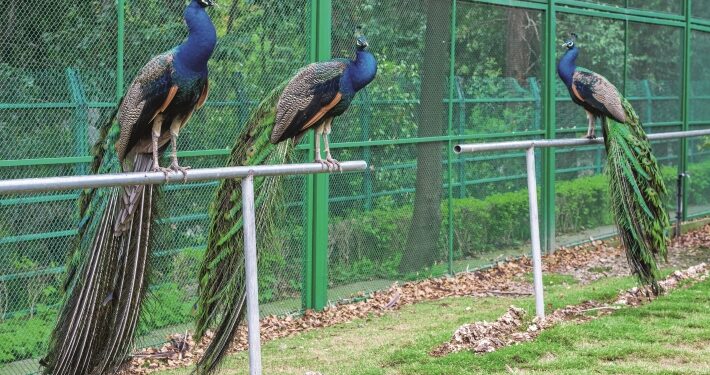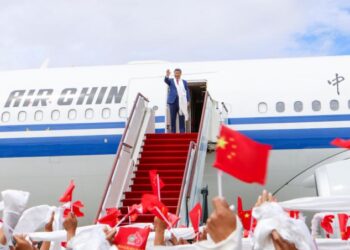SAIC Motor’s Lingang plant, a pioneer in China, fully integrates traditional and new energy vehicle technologies. (COURTESY)
Automated vehicles zip through the workshop of SAIC Motor Passenger Vehicle in Lingang, Shanghai, transporting various parts to multiple production lines. A huge robotic arm operates with uninterrupted, silent precision. Unlike traditional factories, here, the hum of machines dominates, while the usual noise of conversation is almost nonexistent.
SAIC Motor, one of the leaders of China’s auto industry, is not alone, however. A growing number of factories are adopting cutting-edge technologies such as robotics, artificial intelligence and big data to transform their production environments. These innovations are supporting a new round of industrial upgrading in Shanghai, a Chinese economic stronghold.
This eastern Chinese city is at the heart of an industrial revolution, fostered by the national policy of supporting strategic emerging industries and technological innovation. The adoption of new-grade productive forces, from large-scale scientific facilities and high-end incubators to technologies in robotics, automobiles and biomedicine, is infusing every aspect of the production process. The result? A substantial improvement in production efficiency and quality.
Smart applications
Located in close proximity to the sea, SAIC Motor’s Lingang base was inaugurated in September 2008. With an area of 1.2 million square meters, the plant is one of SAIC Motor’s key facilities dedicated to the production of vehicles and engines. It manufactures models for the group’s four independent brands – IM, Rising Auto, Roewe and MG – and is also the main innovation center for this iconic company.
Guan Yizhong, general manager of SAIC’s public relations department, recalls that workers in Shanghai were once tasked with hammering and forging complex body panels by hand. Today, the entire manufacturing process is digitalized and coordinated with the help of smart devices and digital platforms.
Along the assembly line, where vehicles move at a steady pace, workers focus on precise tasks such as tightening screws or marking points, while more complex or demanding tasks are carried out by robotic arms. “On average, a new car comes off the line every 70 seconds at this plant,” said Chen Peifeng, the base’s director.
In 2023, SAIC Motor broke sales records, with 1.21 million vehicles exported, up 18.8% year-on-year, ranking first in the country and positioning China to surpass Japan as the world’s largest automobile exporter. Sales of new energy vehicles (NEVs) were particularly notable, with 1.12 million units sold, up 4.6% year-on-year.
The Lingang base exemplifies the transformation and upgrading of Shanghai’s traditional auto industry. NEV production reached 1.29 million units in 2023, up 35 percent year-on-year and accounting for 13.4 percent of the national output, according to data from the Shanghai Bureau of Statistics. The megacity is thus at the forefront of the NEV industry, prioritizing intelligence, digitalization and sustainable development.

A cold-rolled steel plant of Baosteel in Baoshan District, Shanghai. (XINHUA)
Sustainability gains
Located 80 km away from SAIC’s Lingang base, Baosteel, a subsidiary of giant China Baowu Steel, is also undergoing a profound industrial transformation. Located in Shanghai, this major state-owned steel company has greatly contributed to the structural upgrading of China’s steel industry, strengthening its position through strategic mergers and acquisitions to become a highly modernized global leader.
Baosteel’s plant exemplifies Shanghai’s commitment to green and modern manufacturing. In its cold-rolling shop, an advanced artificial intelligence system runs the core operations with just three operators. Robots have supplanted manual labor, allowing lights to be turned off frequently to save energy, even during the production of complex automotive panels, which takes place in near darkness.
The steel sector, traditionally energy-intensive and a major emitter of CO2is at the heart of sustainable development issues. Baosteel does not just produce some of the best steel in the world; the company is also focused on reducing its carbon footprint. In particular, it has developed a pioneering technology for flue gas treatment, meeting the strictest industry standards. An innovative system for treating gases emitted by coke ovens helps to significantly reduce emissions.
Baosteel’s environmental commitment is also demonstrated through an on-site zoo, which is home to 65 sika deer, 76 blue peacocks and various birds, all protected and thriving for over 30 years. “The good health of these sensitive species is a testament to the environmental quality of our site,” said Li Jungong, chief engineer of the zoo.
In recent years, Baosteel has also made significant progress in developing low-carbon metallurgical processes. Liu Shijun, deputy general manager of the operation center, pointed out that the company has announced an ambitious plan for carbon neutrality, with the goal of reducing emissions by 30% by 2035 and achieving carbon neutrality by 2050.

Peacocks at Baosteel Zoo in Shanghai. (COURTESY)
Increase the level of innovation
At CHINT’s transformer plant in Shanghai, robots are revolutionizing production by stacking 0.23mm-thick silicon steel sheets with remarkable precision and speed. Each robot does the work of six experienced workers, stacking more than 1,680 layers in 24 hours.
CHINT has also innovated in the use of materials, replacing the mineral oil traditionally used in transformers with vegetable oil. This renewable and biodegradable substitution has reduced carbon emissions by 98%. The company has achieved a major milestone with the development of a 750 kV transformer filled with natural ester, achieving the highest voltage level ever achieved, positioning CHINT as the global leader with the largest market share in terms of sales volume of natural ester transformers.
Internationally, CHINT has expanded its reach to more than 100 countries, from icy Finland to the deserts of Saudi Arabia and the rainforests of Ecuador. Chen Chengjian, vice president of the group’s power company, reveals that international operations make up about 30% of the company’s total revenue.
In terms of sustainability, CHINT has built photovoltaic installations with a total capacity of more than 30 GW across the world, generating more than 34 billion kWh of green electricity per year and reducing CO emissions.2 of more than 30 million tonnes.
Innovation is at the core of CHINT’s strategy. By the end of 2022, the company had developed more than 900 products and obtained 404 patents, contributed to the revision of 215 national industrial standards, and participated in more than 30 collaborative projects between industry, academia and research.








